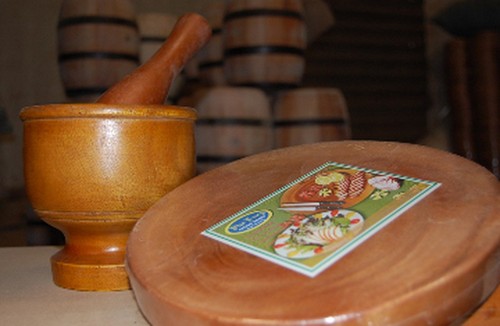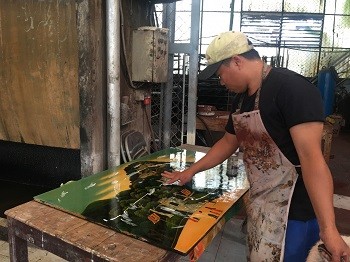
Traditional products of Phu Long craft village in Binh Duong (Photo: plo.vn)
|
Binh Duong province is famous for a number of handicrafts. One is the wooden cutting boards which Phu Long village in Thuan An city has been making for nearly a century. Although Phu Long cutting boards are exported to the US, France, South Korea, and Japan, the craft is in danger of extinction.
Le Thi Hoa, the owner of the Phương Quang cutting board workshop, says she is determined to keep her father’s trade alive.
“Sales have not been steady. Sometimes our products are in high demand. At other times they can’t be sold because the market is saturated. Despite the unstable market, village households have never stopped production,” said Hoa.
Binh Duong province has 32 craft villages and 9 traditional trades, including pottery, lacquerware, wood carving, and knitting.
|
 Tuong Binh Hiep lacquer village works to preserve and develop traditional values. Tuong Binh Hiep lacquer village works to preserve and develop traditional values.
(Photo: baobinhduong.vn)
|
To preserve and promote its craft villages and traditional trades, Binh Duong has built concentrated areas like the one for Tuong Binh Hiep lacquer village, which covers 54,000 square meters and will be put into operation in 2023. It includes a production area, an exhibition area, a temple, and a village gate.
The complex is an attempt to revive a traditional craft that has been recognized by the Ministry of Culture, Sports and Tourism as a national intangible cultural heritage.
Meritorious artisan Le Ba Linh said local artisans are happy about the concentrated production area.
“Binh Duong is a place where the competitiveness of labor is serious. What worries lacquer craftsmen is training successors who will preserve their time-honored craft,” said Linh.
For two years Binh Duong has been developing tourism in combination with its traditional craft villages.
Nguyen Duc Minh, Director of the Binh Duong Tourism Promotion Center, said the tourism sector is working with craft villages to design tours which allow tourists to participate in the production process to see just how the products are made.
Minh added, “Travel agents and traditional lacquer, pottery, bamboo, and rattan craft villages are working together to set up tours. One of the most attractive tours is the tour of a large roadside jar market near the Tuong Binh Hiep lacquer village.”
To protect the environment, producers with low pollution such as Tan Uyen bamboo and rattan and Thu Dau Mot wood carving can keep their current household production model, but those at higher risk of causing environmental pollution, like producers of ceramics and clay piggy banks, must move some of their production stages out of residential areas.
Binh Duong’s concentrated production areas are a way to address the pollution issue while boosting profitability.